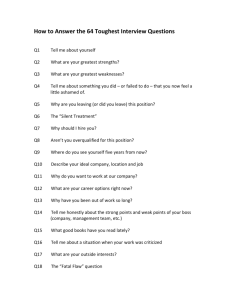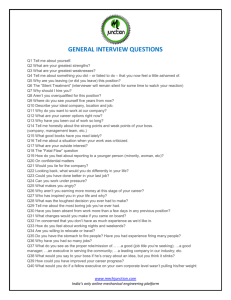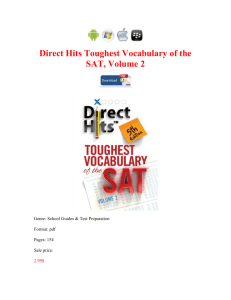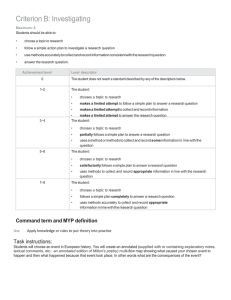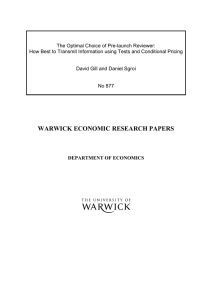The Optimal Choice of Pre-Launch Reviewer: David Gill
advertisement
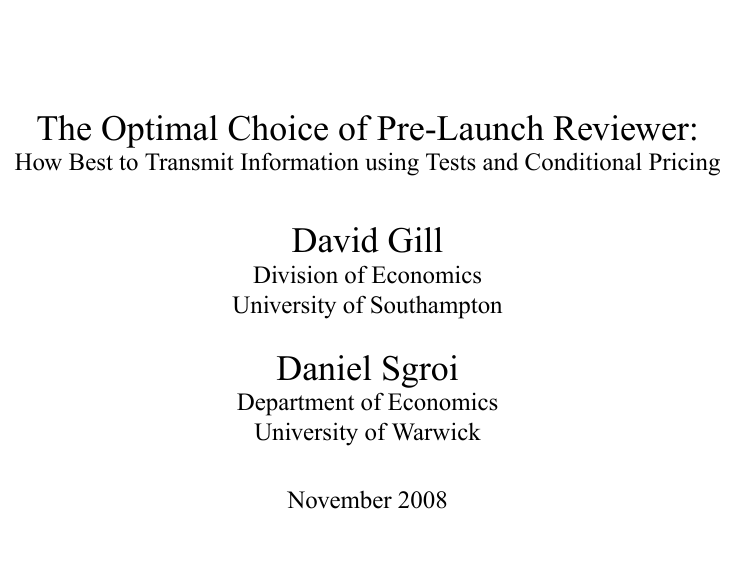
The Optimal Choice of Pre-Launch Reviewer: How Best to Transmit Information using Tests and Conditional Pricing David Gill Division of Economics University of Southampton Daniel Sgroi Department of Economics University of Warwick November 2008 Motivation Public tests can be powerful in launching new products, standards, careers, ideas Reviews Accreditations References Principal discovers whether she is "good" or "bad" type Study the use of a public test by principal to try to convince agents to endorse her Test is passed or failed Information transmission problem Principal chooses toughness of test from a continuum of test types Higher probability of passing a softer test Greater impact from passing a tougher test And how pricing should respond to outcome of the public test Note: not studying problem of optimal test expertise 2 / 32 Outline A. Introduction B. Model C. Choice Problem D. Wanting to be Tested E. Extreme Tests are Best F. Choice of Extreme G. Importance of Price H. Conclusion 3 / 32 A. Introduction: Examples Beta-testers & magazine "previews" in software industry Job market candidates choosing referees Premieres at movie festivals Students choosing degree program to attempt Politicians "selling" a policy seeking support from think tanks Technology sponsors using standard setting organizations (SSOs) “Technology sponsors attempt to build standards around their technologies by having them validated by SSOs that range from fully independent to largely captive special interest groups.” (Lerner & Tirole, AER 06) "Price" of endorsement can take different forms, e.g. Standard market price Salary Degree of compromise offered on policy position 4 / 32 A. Introduction: Preview of Results Model not about signalling through choice of test; rather about signalling through decision of testing body All equilibria are pooling Principal always chooses to be tested Test complements the choice of price Choosing toughest or softest available is optimal Ability to condition price on test result crucial in pushing choice to an extreme Toughest test possible where precision of agents' private information is low and prior not too positive Launch innovative product or idea with bang on passing tough test Softest test possible where precision of private information is high Well-know product or idea 5 / 32 A. Introduction: Related Literature 1/2 Lerner & Tirole (AER 06) consider biased SSOs Sponsor attempts to receive certi cation from an SSO Continuum of SSOs which vary in bias for or against sponsor Differences compared to our setup Sponsor does not know her quality SSO discovers sponsor's quality with certainty Users receive no private information Certi cation rule sensitive to any anticipated price response to decision Thus certi ers cannot counter bad private information And certi cation does not enable a rise in price Sponsor happy to commit to price Given certi cation rule adjusts if price set conditional on decision So no role for certi ers biased against the technology Choose SSO most biased in favor, subject to users adopting following certi cation 6 / 32 A. Introduction: Related Literature 2/2 High initial prices in Taylor (REStud 99) and Bose et al. (RAND 07) play qualitatively similar role to tough reviewers Bose et al.: if expensive good becomes successful conveys strong positive information to later buyers Taylor: if expensive house not sold quickly, prospective buyers can attribute failure to sell to product being overpriced Payment structures to certi cation intermediaries Lizzeri (RAND 99) and Albano & Lizzeri (IER 01) Ask how intermediaries affect product quality Disclosure may be incomplete, but no bias allowed Ottaviani & Prat (Econometrica 01) consider use of certi er Again no bias; neither buyer nor seller fully informed Public signal correlated with buyer's information reduces buyer's rents given 2nd-degree price discrimination Gill & Sgroi GEB 08: herding model without prices 7 / 32 B. Model: Timing Nature chooses unveri able principal type V 2 f0, 1g "Good" type: V = 1 "Bad" type: V = 0 Prior q 2 (0, 1) that principal is good type Type draw observed by principal but not agents N agents each receive a private signal about type of principal Principal decides whether to face public test If tested, chooses type of test to face, which is public Test is passed or failed Principal chooses price λ Conditioned on chosen test type and test decision Agents simultaneously decide whether to endorse 8 / 32 B. Model: Test Technology Testing body receives one signal from fH, U, Lg pzV is probability test receives signal z given principal of type V H pH 1 > p0 , so H is a high signal pL1 < pL0 , so L is a low signal U pU 1 = p0 , so U is an uninformative signal pzV > 0, so no signal is fully informative L When pH 1 = p0 , we call signal structure "symmetric" Testing body makes a decision d 2 D = fP, Fg φ zP is probability test is passed on receiving signal z U L Principal chooses test type φ = φ H P ,φP ,φP W.l.o.g. φ H φ LP , so P is good news and F bad news P Call tests with lower φ U P "tougher" Call tests with higher φ U P "softer" Coarseness of binary report relative to trinary information is key 9 / 32 B. Model: Agents Each agent draws one signal from nite set X = f0, 1, 2, ..., Mg Draws are i.i.d. conditional on V And conditionally independent of test's signal pm V is probability agent receives signal m given principal of type V pm V > 0, so no signal is fully informative m If pm 1 = p0 for all m, agents receive no private information µ = Pr[V = 1jm, φ , d, λ ] is an agent's posterior belief Agent endorses iff his µ λ If agent endorses, u = V λ If doesn't endorse, u = 0 Endorse at indifference is w.l.o.g. µ m = Pr[V = 1jm] is an agent's posterior having observed only his private signal 10 / 32 C. Choice Problem: Introduction Principal aims to maximize expected revenue R Complicated choice problem For every possible test and decision, M + 1 possible prices Anticipated price choices feed back into choice of test And principal needs to worry about inferences from choice of test and price First, we rule out inference from choices per se All equilibria are pooling Then we show that principal will always choose L U φH P = 1, φ P = 0 and φ P 2 f0, 1g Toughest or softest test available Finally, we compare the toughest and softest tests Analytical results And some numerical analysis 11 / 32 C. Choice Problem: Ruling out Separation 1/2 Throughout we restrict principal to pure strategies Perfect Bayesian Equilibrium is the solution concept Separating equilibria are impossible At node where actions differed, action would fully reveal type Bad principal could costlessly copy the choice of good principal Would then be believed to be good for sure by all agents And agents would ignore test So in equilibrium choice of test and price uninformative 12 / 32 C. Choice Problem: Ruling out Separation 2/2 Equilibrium selection issue among pooling equilibria Any pooled strategies form a PBE Conditional on pooling, let Ω be good type of principal's set of optimal strategies We restrict attention to pooling equilibria with strategies in Ω Good type of principal chooses test and pricing rule Justi ed if, starting from a pooling equilibrium with strategies outside of Ω Deviations to Ω weakly increase beliefs that principal is good type 13 / 32 C. Choice Problem: Revenue Function 1/2 In equilibrium, an agent's posterior belief given by µm d = Pr [djV = 1, φ ] µ m Pr [djV = 1, φ ] µ m + Pr [djV = 0, φ ] (1 µ m) Principal chooses price λ 2 µ 0d , µ 1d , ..., µ M d Setting λ = µ m results in endorsements from agents with signals d k : µk µm Standard price-quantity trade-off If λ outside this set, could increase price a little with no loss of endorsements W.l.o.g. normalize number of agents to 1 14 / 32 C. Choice Problem: Revenue Function 2/2 Given φ and d, optimal pricing results in expected revenue k µ m p1 max µ m d ∑k:µ k m2X So given φ , but before test decision is known, expected revenue is R = ∑D Pr [djV = 1, φ ] max µ m d ∑k:µ k k µ m p1 = ∑D max Pr [djV = 1, φ ] µ m d ∑k:µ k k µ m p1 m2X m2X Principal chooses φ to maximize this 15 / 32 D. Wanting to be Tested 1/2 Theorem 1: The principal strictly prefers any test to not being tested at all Let's compare any test φ to not being tested In absence of a test R = max µ m ∑k:µ k m2X k µ m p1 b be the maximizing m Let m Principal sets λ = µ mb b To target agents with signals at least as strong as m 16 / 32 D. Wanting to be Tested 2/2 Now suppose Principal starts with belief µ mb about her type b After the test, principal must set λ = µ m d Then test of no use as Pr Pjφ However b µm P µ mb = Pr Fjφ µ mb b µm F Principal knows she is a good type And can choose how many agents to target conditional on d 17 / 32 E. Extreme Tests are Best: Test Toughness L De nition: (For xed φ H P and φ P ) (i) Test "toughness" is decreasing in φ U P (ii) Test "softness" is increasing in φ U P A pass raises beliefs while a fail lowers them m m µm P > µ > µF The softer the test ∂ µm P < ∂φU P ∂ µm fail: ∂ φ UF P The smaller the positive impact of a pass: 0 And the bigger the negative impact of a But the greater the chance of passing <0 The tougher the test The bigger the positive impact of a pass And the smaller the negative impact of a fail But the smaller the chance of passing 18 / 32 E. Extreme Tests are Best: Convexity Remember R = ∑D max Pr [djV = 1, φ ] µ m d ∑k:µ k m2X k µ m p1 U Can prove that Pr [djV = 1, φ ] µ m d is strictly convex in φ P L For any φ H P and φ P Convex analysis then makes life easy Maximum of strictly convex functions is strictly convex As is sum of strictly convex functions Thus R is strictly convex in φ U P U H L So maximized at φ U P = 1 or φ P = 0, for any φ P and φ P Always choose toughest or softest test Clearly, result extends to any nite set of toughness levels 19 / 32 E. Extreme Tests are Best: Intuition 1/2 We've seen that all prices are decreasing in φ U P Pass raises beliefs more the tougher the test Fail not so damaging if test is tougher U In fact, µ m P strictly convex in φ P Conditional on a pass, increasing toughness more powerful the tougher the test already is But probability of pass is linear in φ U P To maximize Pr [PjV = 1, φ ] µ m principal chooses extreme φ U P P Toughest test Bene t from a steep increase in prices as φ U P !0 While probability of pass falls linearly Softest test Linear increase in probability of pass While prices do not fall much as φ U P !1 20 / 32 E. Extreme Tests are Best: Intuition 2/2 U Pr [FjV = 1, φ ] µ m F maximized at φ P = 0 U Both Pr [FjV = 1, φ ] and µ m F are decreasing in φ P Pr [FjV = 1, φ ] µ m F also convex Summing over the 2 cases, principal always prefers extreme φ U P Chooses either extreme tough type To maximize prices At cost of lower probability of passing Or extreme soft type To maximize probability of passing At cost of lower prices 21 / 32 E. Extreme Tests are Best: High & Low Signals L No comparable notion of toughness for φ H P and φ P Higher φ H P Raises beliefs more after a pass And lowers them more after a fail (φ H F #) Lower φ LP does same H L For any φ U P , R maximized at φ P = 1 and φ P = 0 m Maximize µ m P and minimize µ F Makes pass and fail signals as informative as possible Principal knows her type to be good So wants to transmit information as clearly as possible H If φ H P < 1, so φ F > 0, some chance fail followed a high signal If φ LP > 0, some chance pass followed a low signal L As φ H P ! φ P , the test becomes uninformative 22 / 32 E. Extreme Tests are Best: Formal Results Theorem 2: L U Principal always selects φ H P = 1, φ P = 0 and φ P 2 f0, 1g, i.e., principal chooses a test which is as tough or as soft as possible on receiving an uninformative signal, and which always returns a pass on receiving a high signal and a fail on receiving a low signal Furthermore: U U U For any nite set of φ U P values such that φ P1 > φ P2 > ... > φ PS , U U φ P1 or φ PS strictly preferred by principal to any intermediate test U with φ U / φU Ps 2 P1 , φ PS 23 / 32 F. Choice of Extreme: Analytical Results U Does principal prefer toughest (φ U P = 0) or softest (φ P = 1) test? L When φ H P = 1 and φ P = 0 Suppose test's signals are symmetric L pH 1 = p0 Theorem 3: For suf ciently informative agent signals: Principal strictly prefers softest test For suf ciently uninformative agent signals and q > 21 : Principal strictly prefers softest test For suf ciently uninformative agent signals and q 1 2: Principal strictly prefers toughest test 24 / 32 F. Choice of Extreme: Intuition When agent signals are very uninformative Principal expects agents to start with beliefs close to prior q So when q is high, limited scope to raise price using the test Choose softest test, which is likely to be passed (Even though failing a soft test is quite damaging) And when q is low, bigger scope to raise price using the test Choose toughest test, which gives big upward impact if passed Low initial agent beliefs encourages risk-taking When agent signals are very informative Principal expects agents to start with good beliefs Little upside from risking toughest test So choose softest test 25 / 32 F. Choice of Extreme: Numerical Example 1/5 For intermediate precision of agent information Can't provide general description of test choice Although a given principal can calculate optimal test Suppose q = 12 Agents signal set is binary p11 = p00 = pA p10 = p01 = 1 pA pA 2 1 2,1 pT 2 1 2,1 measures informativeness of agents' signals Test signals 2 L pH 1 = p0 = (pT ) U pU 1 = p0 = 2pT (1 pT ) H p0 = pL1 = (1 pT )2 measures informativeness of test's signals Can think of test receiving two i.i.d. draws from binary signal set 26 / 32 F. Choice of Extreme: Numerical Example 2/5 Figure 2: R(1) R(0) 0 -0.05 -0.1 -0.15 0.5 0.5 0.625 0.625 pT 0.75 0.75 0.875 0.875 1 1 pA 27 / 32 F. Choice of Extreme: Numerical Example 3/5 Figure 3: max fR(1), R(0)g R(No Test ) 0.5 0.375 0.25 0.125 0 0 0.5 0.5 0.5 0.625 0.625 0.75 0.75 pT 0.875 0.875 1 1 pA 28 / 32 F. Choice of Extreme: Numerical Example 4/5 Choice of test matters Choosing correct extreme: up to 15% of max possible revenue Optimal test vs. no test: up to 50% of max When toughest test is best Choosing correct extreme matters more Scope for prices to fall after failing a soft test As pT rises Importance of choosing to be tested goes up Over most of range of pT Toughest test best until pA rises high enough So Theorem 3 extends in natural way Not true for very low pT though 29 / 32 F. Choice of Extreme: Numerical Example 5/5 Figure 5: R(1) R(0) for pT = 0.55 0.002 0.5 0.625 0.75 0.875 1 0 pA -0.002 -0.004 -0.006 30 / 32 G. Importance of Price In Gill & Sgroi GEB 08 Principal seeks endorsement from sequence of agents Potential for herding effects As length of sequence goes to 1 Becomes simpli ed analogue of this model Except "price" is xed And information structure much less general P1: Any test with φ U P < 1 2 preferred to any other test with φ U P P2: From continuum principal selects test with φ U P just below Proof method is very different 1 2 1 2 Recursive method used to nd R Despite differences, helps elucidate impact of prices They drive optimal choice of test to an extreme 31 / 32 H. Conclusion Public tests Can be important and effective way of transmitting information But have received little attention in the literature Our principal always prefers to be tested And choice of test can matter a lot With conditional pricing, choosing an extreme test is optimal Toughest test where quality of information and prior are low Softest test where quality of information is high In IO setting, integrate two key choices for rm launching a new product Choice of initial price Testing as a product marketing strategy Findings might explain existence and survival of Reviewers with harsh styles, biases and critical approaches And very easy tests or “yes-men” 32 / 32
